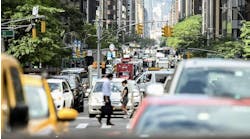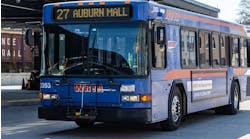Apr. 12—Officials at the San Francisco Municipal Transportation Agency believe that nearly 21% of people who board Muni buses and trains aren't paying a fare. Now they're planning to double the number of fare inspectors to try to reverse the rise in fare evasion.
Fare evasion has long vexed Muni and BART, the Bay Area's largest transit agencies. The SFMTA, which operates Muni, estimated in 2019 that 12.8% of riders evaded paying a fare. Agency officials say they believe that figure has climbed to roughly 20.8%.
The updated Muni fare evasion estimates come as SFMTA and BART face new requirements to study and address fare evasion on their transit system as part of last year's state transit subsidy deal.
Unlike BART, which relies heavily on fares to pay for its service costs, Muni transit fares fund about 8% of the SFMTA's annual operating costs. Still, the high rate of fare evasion could be costing the transportation agency millions of dollars in annual revenue as it faces nine-figure operating deficits in the coming years.
Muni has recovered about 71% of its 2019 transit ridership, though its fare revenue recovery has lagged. For instance, the agency projects receiving $108 million in transit fare revenues in fiscal 2025, which begins in July, down from $197 million in fare revenues the SFMTA generated in fiscal 2019.
The agency's Board of Directors is expected to approve a budget this month that includes funding to hire 35 new fare inspectors to bring the agency's fare inspector count back to 2018 levels.
The budget is also expected to maintain about $24 million in discounted fares for low-income residents, seniors and kids and teenagers while partially eliminating a 50-cent Clipper card discount.
The agency temporarily stopped enforcing fare payments during the height of the pandemic, which may have factored into the rise in fare evasion. Transit fare inspections also fell dramatically between 2019 and 2023, down 65%, according to the SFMTA.
"The most important thing that we see from the data is that there is a very direct correlation between the presence of fare inspectors and the rate of fare compliance," said Jeffrey Tumlin, director of the transportation agency.
Tumlin said the agency will try to hire the "right amount" of fare inspectors that would yield more fare revenues, but not too many to the point where hiring costs exceed the benefit of recovered fares. Tumlin said the agency wants to use inspectors as deterrents for fare evasion, not necessarily to generate more revenue through citations.
Agency officials hope more fare inspectors will also make riders feel safer on Muni.
"Our fare inspectors play a dual role of helping to make people feel safe and secure," said Amanda Eaken, chair of the agency's board of directors. "Because our operators have their hands full driving the bus, they cannot also create a safe space."
The suspected fare evasion rate of 20.8% may feel lower than reality to some Muni riders who commonly observe people boarding buses without tagging a Clipper reader. Most people who boarded the back of a northbound 49-Van Ness bus on a recent weekday didn't tag a Clipper reader with a physical or digital Clipper card, the most common way to pay.
Mike Fogarty, a frequent rider of the 49 and 45 buses, said he often sees about half of riders on these routes not tag a Clipper reader as they board. He's in support of more fare inspectors "if it pays for itself."
"It makes no sense paying a bunch of guys to sit around and do nothing, though," Fogarty said. "They'd have to be paying attention and catching the people who don't pay and give them a ticket or something. But if they don't do that, why bother?"
It's difficult to determine exactly how many non-tagging riders aren't paying a fare. Tumlin said most people who aren't tagging in are, in fact, paying a fare.
Beyond Clipper, riders can also pay through the MuniMobile app, which doesn't require tagging a Clipper reader. People who utilize fare discounts also don't have to pay or tag. Riders attending events at Chase Center or other large events such as Outside Lands in which Muni is free also don't have to tag to ride.
But Bree Mawhorter, chief financial officer at the SFMTA, acknowledged that the common sight of seeing people not tag into a Clipper reader as they board Muni transit creates a "damaging" perception.
Mawhorter told the agency's board of directors this month that much of the public feedback gathered for the upcoming budget centered around concerns about enforcement of fare payments. "Almost everywhere I went in every jurisdiction, with every group in every neighborhood, there was a lot of perception that people don't pay, and a worry that if others observe people not paying that they'll feel like, 'Well, why should I pay?' "
Reach Ricardo Cano: [email protected]; Twitter: @ByRicardoCano
___
(c)2024 the San Francisco Chronicle
Visit the San Francisco Chronicle at www.sfchronicle.com
Distributed by Tribune Content Agency, LLC.

